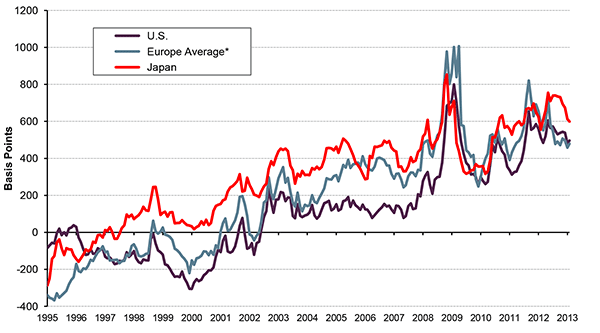Although volatility is likely to stay relatively high going forward, the recent move in the markets to risk-off mode appears to be a temporary condition.
by Scott Minerd, Chief Investment Officer, Guggenheim Partners LLC
Investors can continue to expect more volatility in the periods ahead. Whether the cause is the hung Italian election, statements or actions by any of the world’s major central banks, or the looming sequester, the net effect is the same: heightened uncertainty from political noise. Despite markets becoming more susceptible to policy-related risk, investment fundamentals have not changed. On the other side of this noisy air pocket, asset prices are likely to continue to rise. Credit spreads will keep coming in, and the VIX, which rose from 13.7 to 19.2 to start the week, is likely to re-trace, which means the equity market should rise to fill the gap created over the last number of days.
One consequence of this temporary flight to safety will likely be a fall in interest rates. Treasury yields broke their recent uptrend, meaning the 10-year note could decline toward 1.6%, which is roughly 20 points off the low for 2012. If this proves to be the case, we will take back most of the increases that we have seen since last year’s bottom. Overall, a fall in rates will stimulate demand for housing and prove a net positive for the return of the virtuous economic cycle.
Economic Data Releases
Strong Housing Numbers in the U.S.
- Existing home sales climbed 0.4% in January to an annual rate of 4.92 million, a better-than-expected reading.
- New home sales jumped 15.6% in January to the highest level since July 2008.
- The S&P/Case-Shiller 20 city home price index rose by 6.8% in December from a year earlier, the biggest yearly gain since July 2006.
- The Conference Board consumer confidence index rebounded to 69.6 in February, after falling for three consecutive months.
- Unemployment claims rose from 342,000 to 362,000 for the week ended February 16th, moving the four-week moving average up by 8,000.
- Regional Fed indices mostly disappointed, with the Philadelphia Fed index dropping sharply in February.
- Leading indicators were up 0.2% in January, in line with expectations.
- CPI was unchanged in January, while core CPI increased 0.3% from December.
Eurozone PMIs Down, While German Readings Improve
- The Eurozone composite PMI showed accelerated contraction, falling from 48.6 to 47.3 in January, reversing three consecutive months of increases. Both manufacturing and services PMIs were down.
- Germany’s manufacturing PMI returned to expansion for the first time in one year.
- The Ifo business climate index in Germany rose to 107.4 in February, the highest since April.
- Exports in Germany fell 2.0% in the fourth quarter, leading the 0.6% decline in GDP.
- PMIs in France remained in contraction, with the services PMI showing an accelerated slowdown.
- Retail sales in Italy increased in December by 0.2%, breaking five months of contraction.
- Consumer confidence in Italy rose in February, up from its lowest level on record in January.
- The HSBC China manufacturing PMI dropped to 50.4 in the February flash estimate from 52.3 a month ago.
Chart of the Week
Relative Attractiveness of Equities Implied by the Fed Model
The long-term correlation between the equity earnings yield and 10-year government bond yields, often referred to as the “Fed model,” is widely used for equity valuations. Despite the recent rally in global equity markets, spreads between equity earnings yields and 10-year government bond yields in major advanced economies are still generally higher than their pre-2008 averages. This implies that equities should have room to grow further, as government bond yields remain at low levels owing to major central banks’ easing policies.
THE SPREAD BETWEEN EQUITY EARNINGS YIELDS AND 10-YEAR GOVERNMENT BOND YIELDS

Source: MSCI, Bloomberg, Guggenheim Investments. Data as of 2/26/2013. Please note: Equity indices are MSCI regional indices; index earnings are trailing 12-month based and have been adjusted to exclude negative earnings. *U.K., Germany, France, Italy, and Spain are used as a proxy for Europe.
This article is distributed for informational purposes only and should not be considered as investing advice or a recommendation of any particular security, strategy or investment product. This article contains opinions of the author but not necessarily those of Guggenheim Partners or its subsidiaries. The author’s opinions are subject to change without notice. Forward looking statements, estimates, and certain information contained herein are based upon proprietary and non-proprietary research and other sources. Information contained herein has been obtained from sources believed to be reliable, but are not assured as to accuracy. No part of this article may be reproduced in any form, or referred to in any other publication, without express written permission of Guggenheim Partners, LLC. ©2013, Guggenheim Partners. Past performance is not indicative of future results. There is neither representation nor warranty as to the current accuracy of, nor liability for, decisions based on such information.
Copyright © Guggenheim Partners LLP












